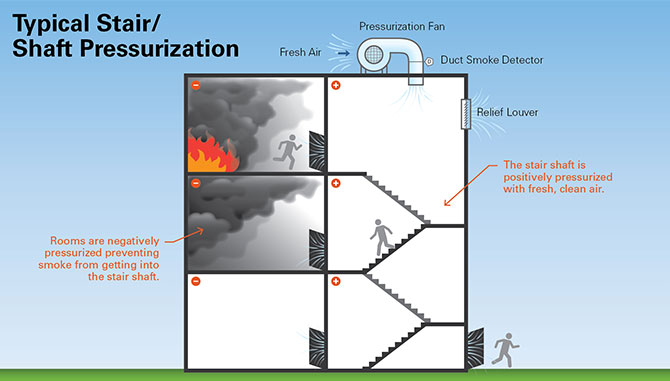Healthcare accreditation agencies are making smoke control system compliance a priority. These systems can become a problematic situation for many hospital facilities that don’t maintain the appropriately detailed records necessary to maintain Deemed Status Compliance. Such compliance is critically important to healthcare facilities, and facility engineers are noticing the increased scrutiny accreditation agencies are putting on existing life safety system testing and documentation.
As a former North Carolina Division of Health Service Regulation inspector, I can attest to the difficulty of this situation. Maintaining smoke control system functionality is an investment that requires an understanding of a system’s major components, original designed intent, as well as an applied understanding of regulatory agencies’ regimens. Without the extensive records on-hand, building owners may find their systems noncompliant after testing them for the first time in years.
Smoke Control Systems in a Nutshell
Smoke control systems are designed to give caregivers the time needed to coordinate patient evacuation protocol. They are composed of a complex combination of mechanical components and electrical controls designed to remove, dilute, or prevent smoke migration within a building.

The complexity of smoke control systems can sometimes overwhelm building owners or contractors who are testing the system. Regulation adds another layer of complexity, which can vary depending on the latest significant addition or renovation. This means that facilities that are older or that have additional features are particularly at risk of non-compliance due to the sheer number of expansions and renovations that may have damaged the fragile system components.
On the bright side, regulations take into account the date of original installation. This means that an original, pneumatic smoke control system installed in a 1960s medical facility could be compliant so long as it performs to the standards required at the time of installation and there exists a detailed list of functions, sequences, component locations, and compliance documentation.

Knowledge is Power
To meet the increasing scrutiny of accreditation agencies, building owners are beginning to seek consultation from specialists with thorough knowledge of past and present building codes in order to prove compliance and system effectiveness. Just this past year, we guided three major North Carolina healthcare facilities through system testing, documentation, and protocols, providing them with an easy-to-understand manual detailing all aspects of their smoke control systems necessary to effectively test the systems.
The manuals we've written provide basic instructions on how these systems work and gives building owners the confidence to handoff system operation, testing, and maintenance to preferred contractors. Since the manuals also inventory every aspect of the system, building owners know exactly what they have and how to test, while accreditation agencies have the thorough documentation necessary to determine facility compliance.
New Year, New Priorities
Accreditation agencies will only become more stringent in their smoke control system performance and documentation inquiries. For that reason, among the many safety considerations, we recommend taking smoke control system analysis seriously heading into 2016.